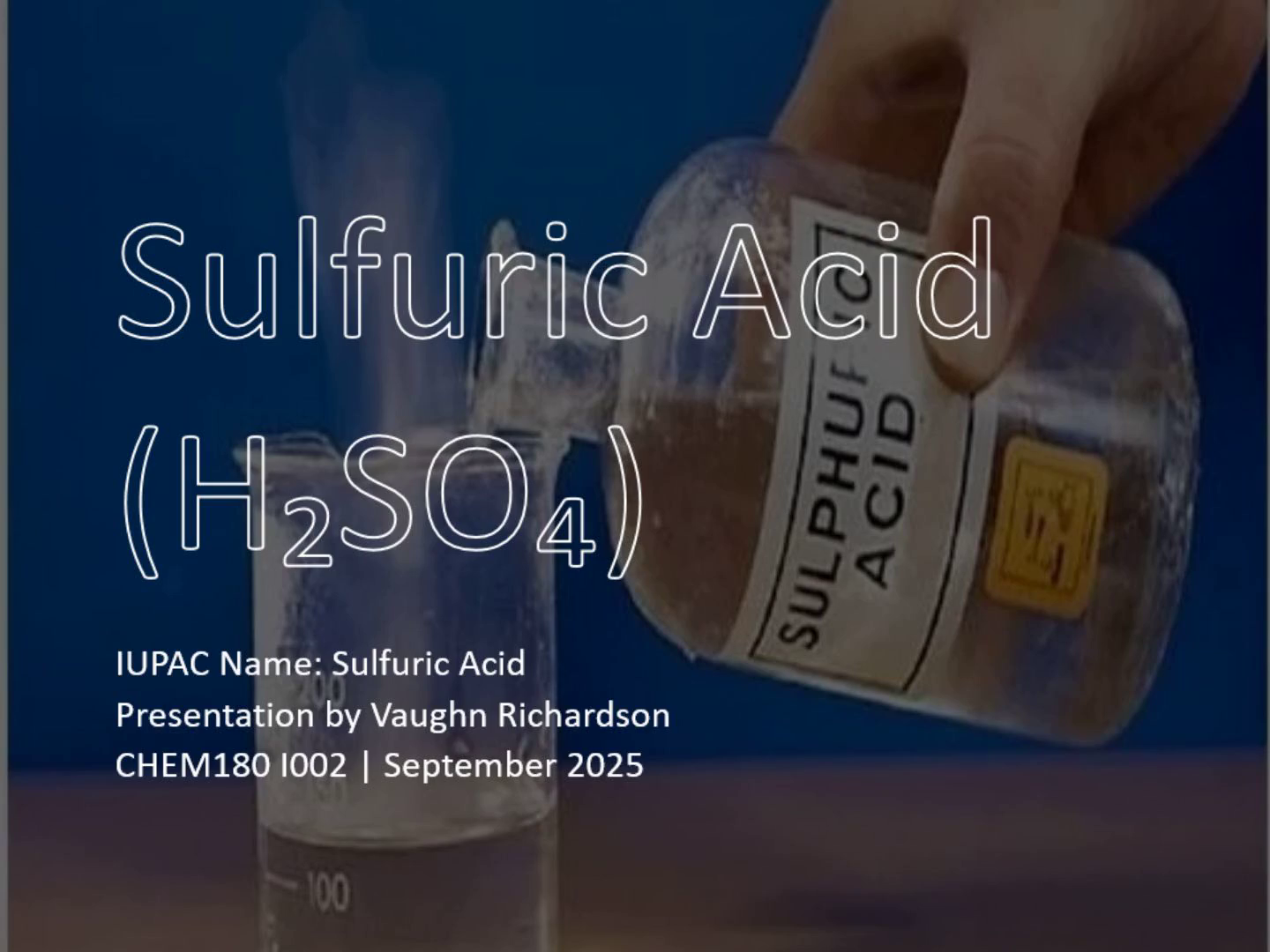
Sulfuric Acid (H₂SO₄)
Scene 1 (0s)
[Audio] Hello class my name is Vaughn Richardson and i will be going over sulfuric acid.
Scene 2 (9s)
[Audio] introduction, Sulfuric acid also known as the "oil of vitriol" is a pretty common chemical used in everyday life..
Scene 3 (25s)
[Audio] The Appearance of sulfuric acid it's clear but the oil like consistency with a yellow tint. Its Density is 1.84 g/cm3 It's Melting Point is 10°C and it's a boiling point is 337°C. The chemical appears odorless so it may go unnoticed and it's a very soluble in water..
Scene 4 (48s)
[Audio] The chemical is a strong acid and it can't cause severe burns to the skin and it's also a dehydrating agent and it's hygroscopic. The chemicals also classified as a group one carcinogen by the IARC.
Scene 5 (1m 7s)
[Audio] In the 8th century The man who made the discovery was Jabir bin Hayyan who was also known as the "father of chemistry ". By the 18th century they started large scale productions and still known as one of the oldest vital industrial assets..
Scene 6 (1m 23s)
[Audio] Sulfuric acid is commonly used in fertilizer, petroleum batteries, and etc..
Scene 7 (1m 39s)
[Audio] When the SO reacts into the atmosphere, it came form acid rain damaging the ecosystem play lakes, and soils harming, wild life and causing corrosion.
Scene 8 (1m 53s)
[Audio] The benefits of sulfuric acid has to society can be vital. This acid can be used on a large skill fertilizer production, manufacturing goods and creating batteries for vehicles and other backup system..
Scene 9 (2m 10s)
[Audio] The harms sulfuric acid can have on society can be very dangerous. This acid can cause severe burns blindness and can even link back to cancer if used improperly or not being fully protective from it..
Scene 10 (2m 29s)
[Audio] To prevent exposure, workers should have full PPE on at all times and monitor the air quality and store the acid in corrosion resistant containers. Emergency eye wash stations / spill neutralizers are required when dealing with this type of chemical..
Scene 11 (2m 47s)
[Audio] In conclusion, we went over one of the most important chemicals in the world known as sulfuric acid. We discussed how valuable it was to our society and also how harmful it can be to personnel. We also talk about the balance of industrial use and regulation essential. Thank you.
Scene 12 (3m 6s)
References (1/2). National Institute for Occupational Safety and Health. (1981). Review and evaluation of recent literature: Occupational exposure to sulfuric acid. United States Environmental Protection Agency. (2025). What is acid rain? Gaines, L., & Sullivan, J. (2010). Critical issues for sustainable lithium-ion battery recycling..
Scene 13 (3m 24s)
References (2/2). Sevin, I. F., & Soucek, L. S. (1981). Review and evaluation of recent literature relevant to occupational exposure – sulfuric acid. Clark Seif Clark. (2022). Identifying and mitigating occupational exposure risks. NIOSH. (n.d.). Sulfuric acid overview page..